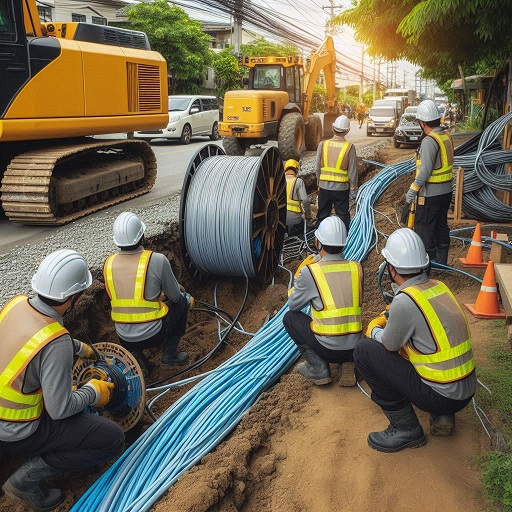Cable blowing equipment is revolutionizing the way industries deploy fiber optic cables. From telecommunications to rural connectivity projects, its efficiency and adaptability make it indispensable. Let’s dive into its key aspects and applications.

Global Cable Blowing Equipment Market Growth Overview
The global cable blowing equipment market was valued at USD 108 million in 2023 and is projected to reach USD 136 million by 2028, experiencing a compound annual growth rate (CAGR) of 4.7% during the forecast period from 2023 to 2029.
Download PDF Brochure @ https://www.marketsandmarkets.com/pdfdownloadNew.asp?id=84541246
Key Drivers of Market Growth
The cable blowing equipment market is witnessing significant growth, driven by several key factors:
- Increasing Demand for High-Speed Internet
The growing need for higher throughput and more reliable internet connectivity is a major factor propelling the demand for cable blowing equipment. - Adoption of 5G Technology
The rapid roll-out and adoption of 5G technology globally have created new opportunities for cable blowing systems, which are essential for the efficient installation of fiber optic cables. - Expansion of Telecommunications Infrastructure in Emerging Economies
The expansion of telecommunications infrastructure in emerging economies further contributes to the demand for advanced cable blowing equipment, helping to meet the increasing connectivity requirements in these regions.
Applications in Different Industries
Telecommunications Sector
The telecommunications industry is a significant user of cable blowing equipment. With the growing demand for high-speed internet, fiber optic cables must be deployed efficiently. Cable blowing enables quicker installations for 5G networks, broadband, and undersea cables, reducing project timelines and costs.
Data Centers and High-Speed Networks
Data centers rely on robust network infrastructure to handle immense data traffic. Cable blowing equipment ensures seamless installation of cables within complex server environments. Additionally, this technology supports the deployment of high-speed backbone networks, facilitating faster data transmission.
Benefits of Cable Blowing Equipment
Cost Efficiency
Cable blowing minimizes manual labor, reducing installation costs significantly. Additionally, the equipment’s precision ensures fewer cable replacements, saving expenses on materials.
Time-Saving Benefits
Traditional methods of pulling cables through ducts are labor-intensive and time-consuming. Cable blowing speeds up the process, allowing companies to complete projects ahead of schedule.
Enhanced Cable Durability
By avoiding excessive physical strain, cable blowing equipment preserves the integrity of cables. This results in longer-lasting installations and reduced maintenance requirements.
Innovations in Cable Blowing Technology
Automation and IoT Integration
Modern cable blowing systems now feature automated controls and IoT-enabled sensors. These advancements allow operators to monitor pressure levels, track progress, and adjust settings remotely, ensuring optimal performance.
Eco-Friendly Advancements
Sustainability is becoming a focus in cable installation. Manufacturers are developing equipment with lower energy consumption and environmentally friendly materials, aligning with global efforts to reduce carbon footprints.
Challenges in Cable Blowing Applications
Overcoming Terrain Challenges
Cable installations often involve varied terrains, such as rocky landscapes, urban infrastructures, or underwater locations. Advanced cable blowing systems are equipped with adaptive technologies to handle these challenges effectively.
Adapting to Different Cable Types
Each project may require different cable types, such as single-mode or multimode fibers. Cable blowing equipment must be flexible enough to handle varying diameters, stiffness, and lengths to ensure compatibility and efficiency.
Comparing Cable Blowing Equipment Types
Portable vs. Stationary Systems
- Portable Systems: Lightweight and easy to transport, these systems are ideal for small-scale projects or locations with limited access.
- Stationary Systems: These are larger, more powerful units designed for extensive installations in industrial settings.
Manual vs. Automated Equipment
- Manual Systems: Operated by technicians, these are budget-friendly but require more effort and precision.
- Automated Systems: Equipped with programmable controls, these systems offer high efficiency and consistent performance, albeit at a higher cost.
Maintenance of Cable Blowing Equipment
Routine Maintenance Checklist
- Inspect the blowing head for wear and tear.
- Ensure the air compressor operates at optimal pressure.
- Lubricate moving parts regularly to reduce friction.
Troubleshooting Common Issues
Common problems, such as uneven air pressure or cable jams, can be resolved by adjusting settings or performing system diagnostics. Proper training helps technicians address these issues efficiently.
Future Trends
AI and Machine Learning in Cable Blowing
Artificial intelligence is being integrated into cable blowing equipment to enhance performance. Features like predictive maintenance and real-time monitoring are transforming the industry.
Global Market Growth Forecast
With increasing demand for high-speed networks, the global market for cable blowing equipment is projected to grow significantly in the next decade.
In conclusion, the applications of cable blowing equipment have transformed the way industries approach cable installation. From telecommunications to data centers and rural areas, this technology has proven to be a game-changer, offering speed, efficiency, and cost savings. The innovations in cable blowing, such as automation and eco-friendly advancements, continue to push the boundaries of what’s possible, ensuring that cable deployment remains a reliable and sustainable process.
FAQs
- What is cable blowing equipment?
It is specialized machinery used to install cables in ducts using air or water pressure. - What industries use cable blowing equipment?
Major users include telecommunications, data centers, and high-speed network providers. - How does cable blowing improve cable durability?
It reduces physical stress on cables, minimizing wear and tear during installation. - Can cable blowing equipment handle all cable types?
Yes, but choosing the right system is critical for specific cable types. - Are there eco-friendly cable blowing systems?
Yes, modern systems focus on energy efficiency and reduced environmental impact. - What training is needed to operate cable blowing equipment?
Operators must undergo certification programs to ensure safe and efficient handling.
